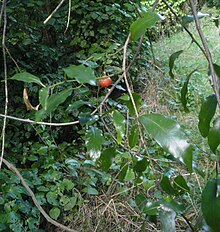Passiflora tetrandra
| Passiflora tetrandra | |
|---|---|

| |
| Scientific classification | |
| Kingdom: | Plantae |
| Clade: | Tracheophytes |
| Clade: | Angiosperms |
| Clade: | Eudicots |
| Clade: | Rosids |
| Order: | Malpighiales |
| Family: | Passifloraceae |
| Genus: | Passiflora |
| Species: | P. tetrandra
|
| Binomial name | |
| Passiflora tetrandra Banks ex DC.
| |
| Synonyms[1] | |
| |
Passiflora tetrandra is a climbing vine found in New Zealand. The Māori name for the plant is kōhia[2]. Other common names include New Zealand passionflower and New Zealand passionfruit.[3] Of the c.500 species of passionflower, this is the sole representative from New Zealand and endemic to New Zealand [4].

Kōhia is a forest vine, climbing up to 10m (33 feet). Leaves are alternate, broadly lanceolate, green, shiny, and untoothed. Flowers are small, white to yellow, in groups of 1-3 in the axils of the leaves. Flowers appear between October and December.
Plants are dioecious: fruit may not be produced without female-flowering plants being fertilised with pollen from separate a male-flowering plants[5][6]. Fruits can be found from summer to autumn[7]; are lemon-shaped, orange, up to 30mm (1.2 inches) long. The fruit can be eaten by people and is a traditional food for Māori: the gum from the stem was also chewed[8].
Propagation is from seed or cutting. Cultivation requirements are basic: vines need a support structure/tree and a cool root run in a reasonable soil[9].
References
- ^ Tropicos
- ^ "kohia". maoridictionary.co.nz. Retrieved 25 July 2012.
- ^ NZ Plant Conservation Network
- ^ Cave, Y., and Paddison, V. (2005) The Gardener's Encyclopedia of New Zealand Native Plants. Randomhouse, Glenfield, New Zealand
- ^ Crowe, A. (1997) A Field Guide to the Native Edible Plants of New Zealand. Penguin Books, North Shore, New Zealand
- ^ Cave, Y., and Paddison, V. (2005) The Gardener's Encyclopedia of New Zealand Native Plants. Randomhouse, Glenfield, New Zealand
- ^ Crowe, A. (1997) A Field Guide to the Native Edible Plants of New Zealand. Penguin Books, North Shore, New Zealand
- ^ Crowe, A. (1997) A Field Guide to the Native Edible Plants of New Zealand. Penguin Books, North Shore, New Zealand
- ^ Cave, Y., and Paddison, V. (2005) The Gardener's Encyclopedia of New Zealand Native Plants. Randomhouse, Glenfield, New Zealand
- ^ Raoul, Étienne Fiacre Louis. 1844. Annales des Sciences Naturelles; Botanique, sér. 3 2: 122.
- ^ Candolle, Augustin Pyramus de, 1822. Prodromus Systematis Naturalis Regni Vegetabilis 3: 323.
- ^ Naturewatch New Zealand
